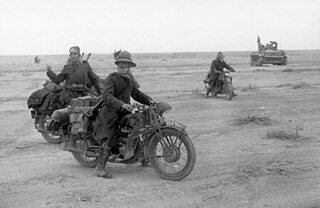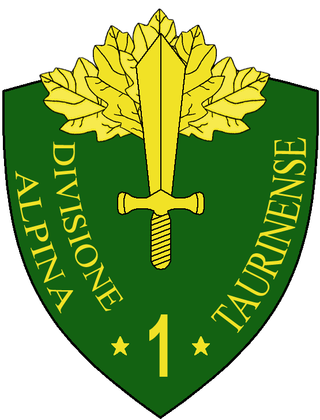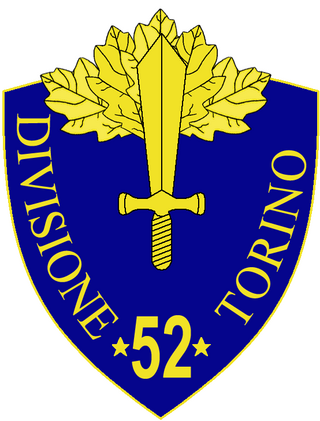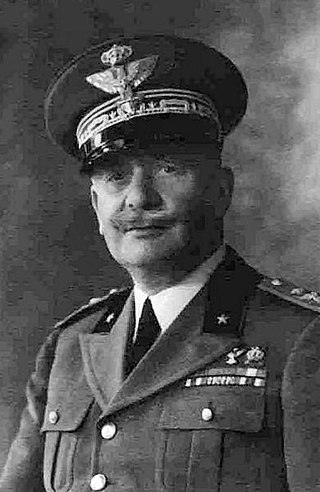Related Research Articles

The 1st CC.NN. Division "23 Marzo" was an Italian CC.NN. division raised on 23 April 1935 for the Second Italo-Ethiopian War against Ethiopia. The name "23 Marzo" was chosen to commemorate the founding date of the Fasci Italiani di Combattimento on 23 March 1919. The division took part in the Italian invasion of Egypt and was destroyed during the Battle of Bardia in January 1941.

The 1st Army was a Royal Italian Army field army, in World War I, facing Austro-Hungarian and German forces, and in World War II, fighting on the North African front.

The 3rd Alpini Regiment is a regiment of the Italian Army's mountain infantry speciality, the Alpini, which distinguished itself in combat during World War I and World War II. The regiment is based in Pinerolo and assigned to the Alpine Brigade "Taurinense".

The 3rd Alpine Division "Julia" was a division of the Royal Italian Army during World War II, which specialized in mountain warfare. The Alpini that formed the divisions are a highly decorated, elite mountain corps of the Italian Army comprising both infantry and artillery units. Today the traditions and name of the 3rd Alpine Division "Julia" are carried on by the Alpine Brigade "Julia".

The 1st Alpine Division "Taurinense" was a division of the Royal Italian Army during World War II, which specialized in mountain warfare. The Alpini that formed the division are a highly decorated and elite mountain corps of the Italian Army consisting of both infantry and artillery units. Today, the traditions and name of the 1st Alpine Division "Taurinense" are carried on by the Alpine Brigade "Taurinense". The headquarters of the division was in the city of Turin and the majority of its soldiers were drafted from the surrounding Province of Turin — therefore the division was named "Taurinense" for the Roman name of the city of Turin Augusta Taurinorum.

The 2nd Alpine Division "Tridentina" was a division of the Royal Italian Army during World War II, which specialized in mountain warfare. The Alpini that formed the divisions are a highly decorated and elite mountain corps of the Italian Army comprising both infantry and artillery units. The name Tridentina was chosen as the division was based in the Trentino-South Tyrol region, for which the fascist regime of Benito Mussolini had created the neologism Venezia Tridentina. After World War II, the traditions and name of the 2nd Alpine Division "Tridentina" were carried on by the Alpine Brigade "Tridentina".

The 4th CC.NN. Division "3 Gennaio" was an Italian CC.NN. division raised on 25 June 1935 for the Second Italo-Ethiopian War against Ethiopia. The name "3 Gennaio" was chosen to commemorate the date of assumption of dictatorial powers by Benito Mussolini on 3 January 1925. The division took part in the Italian invasion of Egypt and was destroyed during the Battle of Sidi Barrani in December 1940.

The 52nd Infantry Division "Torino" was an infantry division of the Royal Italian Army during World War II. The Torino was named after the city of Turin and classified as an auto-transportable division, meaning it had some motorized transport, but not enough to move the entire division at once. The division was formed by expanding the Torino Brigade in June 1940 and was based with two of its regiments in Civitavecchia, while the 81st Infantry Regiment "Torino" was based in Rome. The division took part in the Invasion of Yugoslavia and was then sent to the Eastern front as part of the Italian Expeditionary Corps in Russia.
The 203rd Coastal Division was an infantry division of the Royal Italian Army during World War II. Royal Italian Army coastal divisions were second line divisions formed with reservists and equipped with second rate materiel. Recruited locally, they were often commanded by officers called out of retirement.
The 204th Coastal Division was an infantry division of the Royal Italian Army during World War II. Royal Italian Army coastal divisions were second line divisions formed with reservists and equipped with second rate materiel. Recruited locally, they were often commanded by officers called out of retirement.

The 44th Infantry Division "Cremona" was an infantry division of the Royal Italian Army during World War II. The Cremona was formed on 15 September 1939 by splitting the 20th Infantry Division "Curtatone and Montanara" into the 20th Infantry Division "Friuli" and 44th Infantry Division "Cremona". The division was named for the city of Cremona. The division served as occupation force on Corsica and fought German units after the Armistice of Cassibile was announced on 8 September 1943. The division then served with the Italian Co-belligerent Army and remained active until the 1975 Italian Army reform.

The 156th Infantry Division "Vicenza" was an infantry division of the Royal Italian Army during World War II. The Vicenza was formed on 10 March 1942 and named for the city of Vicenza. The Vicenza was classified as an occupation infantry division, which meant that the division's artillery regiment consisted of two artillery groups instead of the three artillery groups of line infantry divisions and that the divisional mortar battalion was replaced by a divisional machine gun battalion. The division was sent to the Eastern front, as part of the Italian Army in Russia. The division guarded the army's line of communications and rear area against Soviet partisans.

Operational Land Forces Command is the Italian Army's major command tasked with the operational and administrative control of most of its combat forces. COMFOTER reports directly to the Chief of Staff of the Italian Army. The command is based in Rome.
The Maritime Artillery Militia was an artillery unit of Italy's Milizia Volontaria per la Sicurezza Nazionale. It was active from 1939 to 6 December 1943.

Ugo Santovito was an Italian general during World War II.

Carlo Rossi was an Italian general during World War II.
Army Group East was an Army Group of the Royal Italian Army in World War II.

Gino Pedrazzoli was an Italian general during World War II.

Camillo Grossi was an Italian general during the interwar period and World War II. He was also a member of the Italian Senate from 5 April 1939 until his death in office in 1941.

The 87th Infantry Regiment "Friuli" is an active unit of the Italian Army based in Bologna in the Emilia-Romagna. The regiment is named for the region of Friuli and part of the Italian Army's infantry arm. On 4 October 2022 the name, flag and traditions of the regiment were assigned to the Command and Tactical Supports Unit "Friuli" of the Airmobile Brigade "Friuli".
References
- ↑ "Regio Esercito - Storia delle unità terrestri - Gruppo d'Armate Ovest". Regioesercito.it. Retrieved 2021-10-02.
- ↑ Italian Army General Staff, Bollettino dell'archivio storico dell'Ufficio Storico, n. 3-4, Rome, Ufficio Storico SME, January-December 2002
- ↑ Giorgio Rochat, Le guerre italiane 1935-1943, pp. 248-251
- ↑ "Regio Esercito - Storia delle unità terrestri - Gruppo d'Armate a Disposizione". Regioesercito.it. Retrieved 2021-10-02.